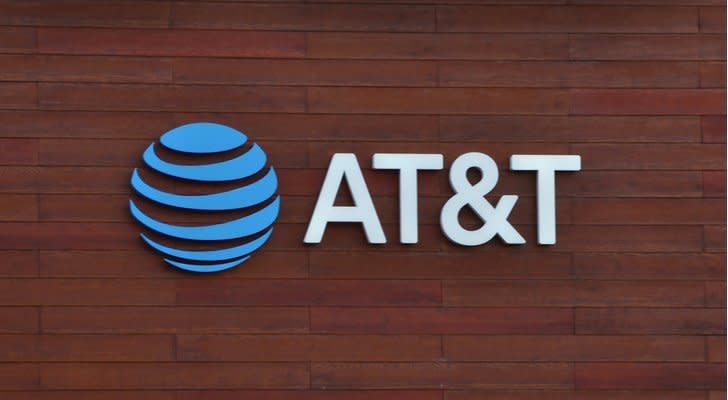AT&T Stock’s TV-Driven Turbulence Will Be Worth It
There’s no denying telecom giant AT&T (NYSE:T) has painted itself into a corner on the television front. But the owners of T stock can at least cheer the fact that, if nothing else, AT&T’s video business should start to deliver better profit margins beginning next year.

Source: Shutterstock
That’s coming at a price, of course. Subscribers of DirecTV Now , a streaming version of the satellite TV service, are cancelling in droves. Over the course of the past two reported quarters, the company has lost 1.3 million video customers. About 350,000 of those former subscribers unwilling to pay the recently-upped rates. AT&T’s upcoming introduction of a Time Warner-streaming product may only fuel more DirecTV cancellations.
Whatever’s in the cards, however, it’s quite clear that AT&T CEO Randall Stephenson is finally willing to swallow the much-needed bitter pill.
InvestorPlace - Stock Market News, Stock Advice & Trading Tips
Dropping Dead Weight
AT&T once assumed that using loss-leader cable-television packages to attract consumers into its ecosystem would ultimately position the company to cross-sell those customers more profitable products like broadband service and even wireless service.
That’s not how things panned out, though. Often sold at a promotional price point that was likely to be less than AT&T’s procurement costs, the DirecTV experiment that began back in 2015 never turned into the cash cow (or even the marketing hook) it was supposed to be.
A little company called Netflix (NASDAQ:NFLX) played a role in that disappointment as well.
And, while what the future holds still isn’t entirely clear now that Time Warner is part of the AT&T family, the owners of T stock can count on the future not looking like the past. Stephenson, AT&T’s CEO, explained the situation at an investor conference hosted by JP Morgan last month:
“This is going to be a year of just cleaning up the video business. And we’ve been hard at work on content agreements and getting content agreements done in a way that gives us sustainability and profitability in this business. But the other element to give you sustainable profitability is cleaning up the customer base. Because we have a number of customers on our rolls that are very low-ARPU (average revenue per user) customers and we don’t see any line of sight to getting them to a profitable level. And so as these customers’ contracts or whatnot are coming up, there are many who are opting to just leave…”
Those lower ARPU customers aren’t entirely gone, though. Analysts and investors alike are anticipating another net loss of DirecTV customers for the current quarter.
But that may actually help T stock
The Price War Is Cooling Off
Sending any customer into a rival’s arms feels like a step in the wrong direction,. But there’s a growing realization among most industry players tha any sort of video package has to be profitable on its own.
MultiChannel News’ Daniel Frankel noted in March that “The new normal (price) for (subscription TV providers) is about to be at least $50 a month.”
That jibes with the $50 to $60 price range AT&T’s Stephenson suggested felt right in December. While that’s still more than Alphabet (NASDAQ:GOOGL, NASDAQ:GOOG) charges per month for access to a cable alternative called YouTube TV, YouTube TV is also believed to be losing money. Hulu, mostly owned by Walt Disney (NYSE:DIS), asks $45 per month for access to live broadcasts, but it, too, remains unprofitable largely because of the steep expenses associated with live television. But archived, on-demand content is relatively cheap.
It wouldn’t be unreasonable to expect rival subscription TV players to also start ratcheting their rates up now that there’s no “early market share” to secure.
As for a non-broadcast streaming service from T, the planned platform from Time Warner will handle those duties.
The hinted monthly price of between $16 and $17 per month for the Time Warner offering would make AT&T’s option pricier than Netflix’s basic package. In fact, at that price point, AT&T’s service would be among the most expensive online, on-demand options. It would be an incredibly robust offering though, so it would have a chance to draw a big enough crowd to enable it to actually operate in the black.
The typical on-demand price point for online video also seems to be stabilizing somewhere between $12 and $20 for a reason. That’s where companies can have a shot at operating in the black but still remain competitive.
The Bottom Line on T Stock
AT&T’s television business is still a moving target. Odds are good that the company will continue to bleed TV customers through the end of the year, as the lower-ARPU crowd balks at price increases and finds other options. And, with the Time Warner service not expected to come online until late this year or early next year, the remainder of 2019 could prove frustrating for the owners of AT&T stock.
Don’t sweat it though. These are growing pains that represents progress along the learning curve. Sustainability is finally becoming a reality, although it’s out of necessity.
AT&T’s rivals are even starting to embrace this reality too, as are investors in T stock who would now rather see healthier profit margins than big-time revenue. That’s especially true, given the company’s plans this year to pay down the lion’s share of the $40 billion worth of debt it took on in order to complete the Time Warner acquisition.
Just don’t be surprised if the transition proves to be an erratic one for AT&T stock price.
As of this writing, James Brumley held a long position in AT&T. You can learn more about James at his site, jamesbrumley.com, or follow him on Twitter, at @jbrumley.
More From InvestorPlace
The post AT&T Stock’s TV-Driven Turbulence Will Be Worth It appeared first on InvestorPlace.

